
As businesses increasingly adopt hybrid work models, teams require reliable tools to enable seamless collaboration, communication, and productivity from any location. These tools are vital for connecting remote workers with their managers and colleagues, whether they’re working from home or the office.
While searching for effective software, many overlook the importance of robust document and knowledge management systems at the core of successful collaboration platforms.
Microsoft SharePoint is one of the most recognized and widely adopted intranet platforms, known for its ability to facilitate document sharing and knowledge management across teams. However, SharePoint is not without its limitations, leading many users to explore alternatives. In this article, we’ll dive into what makes SharePoint so popular and examine some of its top competitors and alternatives.
What is SharePoint?
Microsoft SharePoint is a web-based platform designed to improve collaboration, document management, and organizational efficiency within businesses. It serves as an intranet solution where teams can store, organize, share, and access information securely from any device. SharePoint is widely used for managing company documents, creating team sites, and automating workflows.
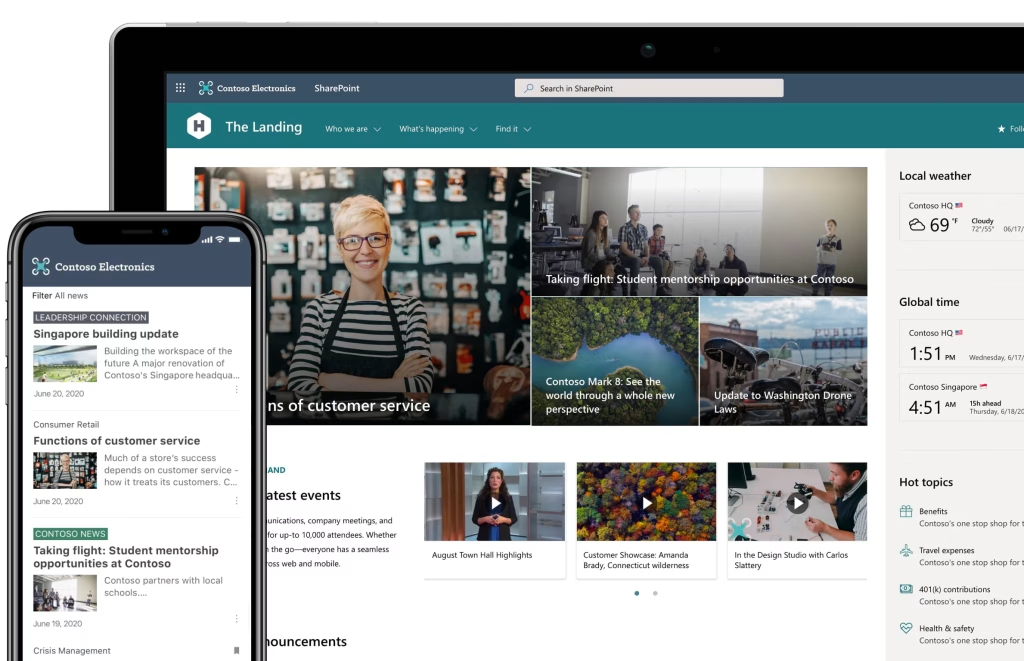
Key Features of SharePoint:
- Document Management
SharePoint enables centralized storage and version control for documents, ensuring that teams always work on the latest versions. It also allows permissions-based access for secure collaboration. - Intranet and Communication
Many organizations use SharePoint as their intranet platform to share announcements, host discussion boards, and keep employees informed about company news and updates. - Collaboration Tools
Teams can create sites for projects, departments, or initiatives, providing a shared space to collaborate, track progress, and store related documents. - Integration with Microsoft Ecosystem
SharePoint seamlessly integrates with other Microsoft products like Teams, OneDrive, and Office 365, offering a unified experience for productivity and collaboration. - Customizability
Businesses can customize SharePoint sites to reflect their branding and meet their specific workflows using built-in tools or custom development.
Limitations of SharePoint:
While SharePoint is powerful, it has its drawbacks:
- Complexity: Its setup and customization can be complicated, requiring expertise.
- User Experience: Some users find the interface less intuitive compared to modern alternatives.
- Cost: Licensing and maintenance costs can be high for smaller organizations.
Who Uses SharePoint?
SharePoint is commonly adopted by medium to large enterprises that require a centralized system for managing documents, workflows, and team collaboration. It’s especially popular in industries with a need for robust compliance and security, such as finance, healthcare, and government.
Despite its popularity, SharePoint may not meet every organization’s needs, which is why many businesses explore alternatives that offer a simpler or more specialized experience.
Main Features of SharePoint
- Document Management and Storage
SharePoint provides centralized storage for files with advanced version control, ensuring teams always work on the latest updates. It also offers robust search capabilities and customizable permissions for secure collaboration. - Team Collaboration
SharePoint enables teams to create dedicated sites for projects, departments, or initiatives. These sites serve as hubs for sharing files, tracking progress, and collaborating in real time. - Customizable Intranet
Organizations can build a fully branded intranet with SharePoint to share company news, host discussion boards, and foster internal communication across departments. - Workflow Automation
SharePoint includes tools to create custom workflows that automate repetitive tasks like document approvals, notifications, or data collection, saving time and reducing errors. - Seamless Integration with Microsoft Ecosystem
SharePoint integrates seamlessly with Microsoft 365 tools, including Teams, OneDrive, and Office apps, providing a unified platform for productivity and collaboration.
These features make SharePoint a comprehensive solution for organizations seeking to enhance collaboration, streamline workflows, and manage content effectively.
Best 5 Alternatives to SharePoint
1. FuseBase
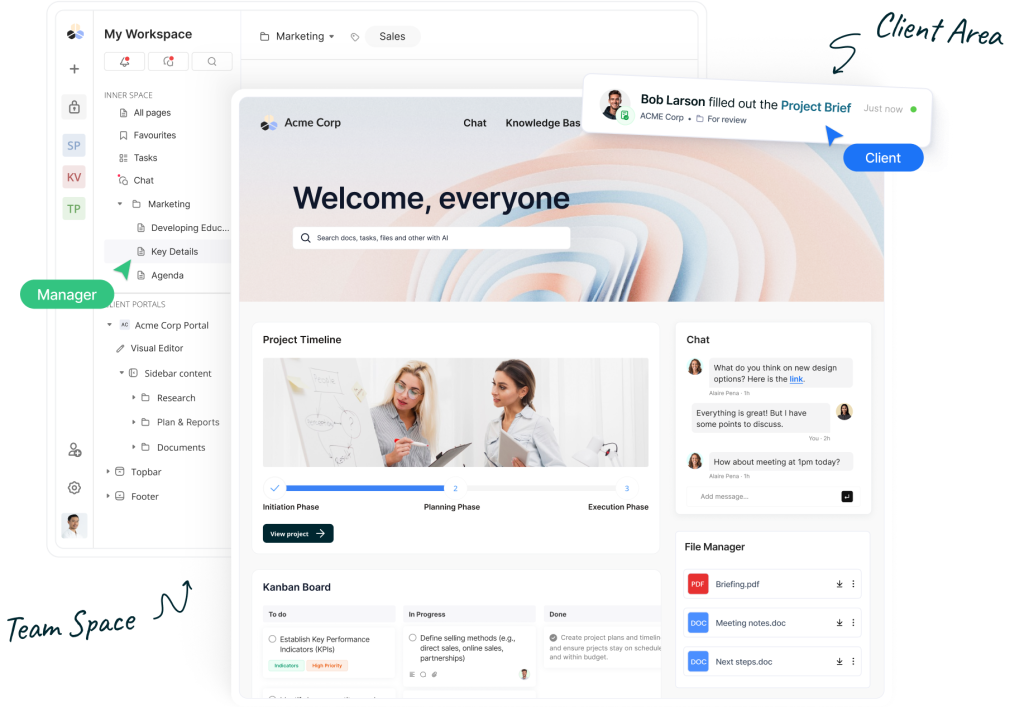
Best for Customizable portals and AI-driven collaboration.
FuseBase offers a modern, flexible platform that combines document management, workflow automation, and customizable portals for team and client collaboration. Its standout features include AI-powered assistance for tasks like document summarization, smart search, and project coordination. FuseBase is particularly appealing for teams seeking a user-friendly alternative to SharePoint with robust security and advanced customization options.
FuseBase stands out as one of the most innovative and versatile alternatives to SharePoint. Designed to address modern collaboration needs, FuseBase combines powerful features, a user-friendly interface, and advanced AI-driven capabilities to help teams streamline their workflows and enhance productivity. Here’s why FuseBase is an excellent choice:
Key Features:
- Customizable Portals
- Create fully branded and tailored client or team portals that cater to specific workflows.
- Add widgets, integrate tools, and design portals to meet unique business requirements.
- AI-Driven Assistance
- Leverage AI for document summarization, smart searches, and project coordination.
- Automate repetitive tasks, such as notifications, file uploads, and task updates.
- Intuitive Collaboration Tools
- Facilitate real-time collaboration through task management, file sharing, and communication tools.
- Consolidate team activities into one platform for better alignment and efficiency.
- Robust Document Management
- Store, organize, and retrieve files with advanced version control and permission settings.
- Ensure secure access with granular control over user roles and data privacy.
- Seamless Integration
- Connect FuseBase with popular apps like Google Workspace, Slack, and more for a cohesive workflow.
- Enable cross-platform compatibility for smoother team operations.
- Enhanced Automation
- Build workflows using FuseBase’s automation module to save time and reduce manual tasks.
- Automate processes such as email notifications, task creation, and data collection.
- E-Signature Functionality
- Simplify document approvals and proposals with built-in e-signature features.
Pricing
Free plan
Standard – $38/user/month
Contact sales for a customized pricing quote
2. Google Workspace
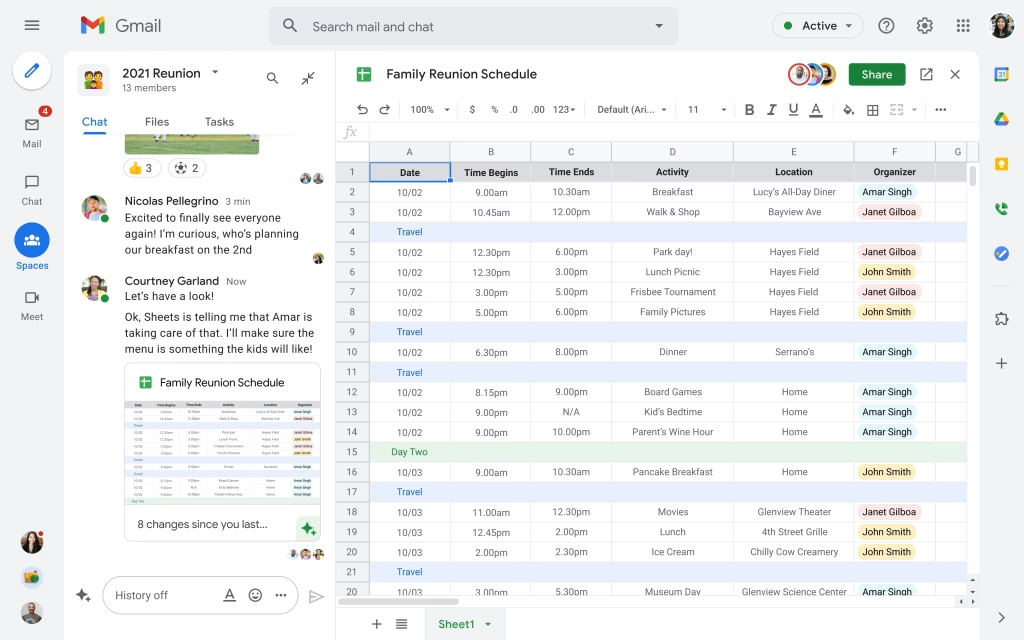
Best for Seamless collaboration within Google’s ecosystem.
Google Workspace provides tools like Google Drive, Docs, Sheets, and Slides, allowing teams to collaborate in real time on documents, spreadsheets, and presentations. Its simple interface and cloud-first design make it ideal for teams that prioritize ease of use and accessibility. With features like real-time editing, built-in chat, and seamless integration with Gmail and Calendar, Google Workspace ensures that teams can stay connected and productive from anywhere. Additionally, its advanced sharing and permissions settings allow secure collaboration, while its robust mobile apps make it easy to work on the go. For businesses of all sizes, Google Workspace offers scalability and flexibility, making it a popular choice for modern teams.
Pricing
- Business Starter: $7.20 per user per mont or $72 per user annually.
- Business Standard: $14.40 per user per month (or $144 per user annually).
- Business Plus: $21.60 per user per month (or $216 per user annually).
- Enterprise: Pricing available upon request; includes advanced security, compliance, and custom features.
3. Notion
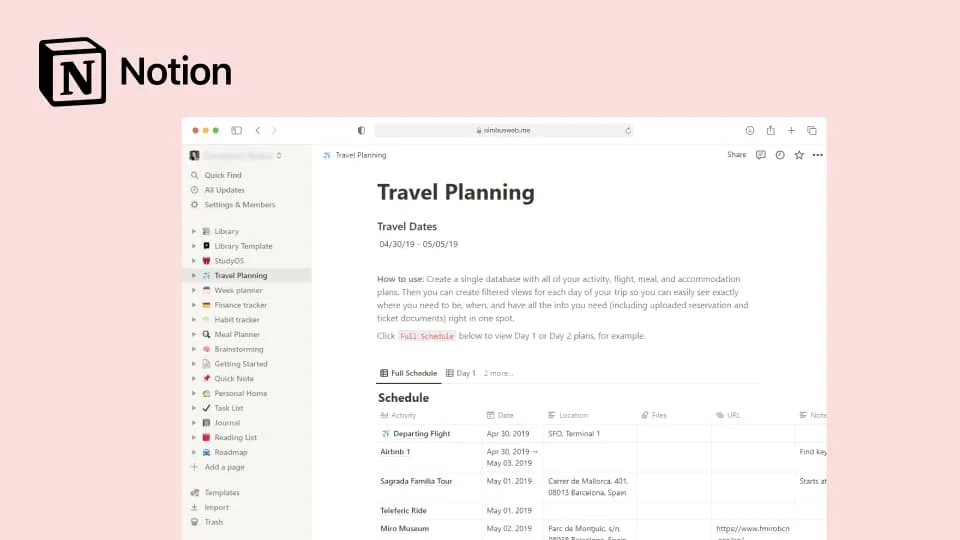
Best for All-in-one team organization.
Notion is a versatile tool that combines note-taking, project management, and document collaboration into one cohesive platform. Its drag-and-drop interface and extensive library of custom templates make it a user-friendly alternative to SharePoint, especially for smaller teams or creative projects. Notion allows users to build fully customized workspaces, enabling them to organize tasks, manage knowledge bases, and track project progress in a way that suits their unique workflows.
With its integration capabilities, Notion connects with tools like Slack, Google Drive, and Zapier, allowing teams to streamline their workflows further. It also supports real-time collaboration, making it easy for team members to contribute and edit content simultaneously. Additionally, Notion’s mobile apps and offline access ensure that users can stay productive even when they’re on the move. Its flexibility and intuitive design make it an excellent choice for startups, freelancers, and teams seeking a modern, lightweight solution for collaboration and organization.
Pricing (per user per month)
- Free Plan: Yes, available for individual personal use.
- Plus: $8 (billed annually) or $10 (billed monthly).
- Business: $15 (billed annually) or $18 (billed monthly).
- Enterprise: Pricing available upon request; tailored for organizations requiring advanced features and support.
4. Box
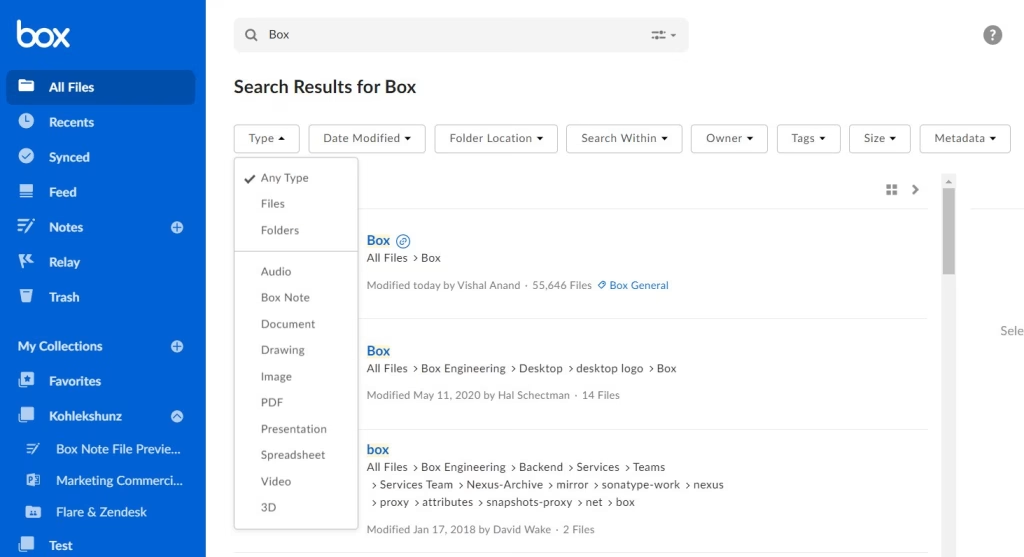
Best for Secure cloud storage and file sharing.
Box specializes in cloud storage with enterprise-grade security features, making it a trusted choice for organizations that prioritize data protection. With advanced encryption, granular access controls, and compliance with industry standards such as HIPAA, GDPR, and SOC 2, Box ensures that sensitive data is securely stored and managed.
It offers seamless integrations with popular productivity tools like Microsoft 365, Google Workspace, Slack, and Salesforce, enabling teams to connect their workflows effortlessly. Box’s collaboration features include real-time file editing, version history, and the ability to assign tasks directly within shared documents.
Additionally, Box provides powerful automation capabilities through its Box Relay feature, which helps teams streamline repetitive processes like document approvals and onboarding workflows. Its mobile-friendly apps and offline access ensure that users can work on files from anywhere, enhancing flexibility and productivity. With scalable storage plans and robust administrative tools, Box is an excellent option for businesses of all sizes looking to optimize document management and team collaboration.
Pricing (per user per month)
- Free Plan: Yes, available for individual personal use.
- Personal Pro: $10 per month for individual users.
- Starter: $5 designed for small teams.
- Business: $15 suitable for larger teams requiring advanced collaboration features.
- Business Plus: $25 offering enhanced security and administrative controls.
- Enterprise: $35 tailored for organizations needing comprehensive content management and security features.
- Enterprise Plus: Pricing available upon request, includes all features plus additional enterprise-grade functionalities.
5. Confluence
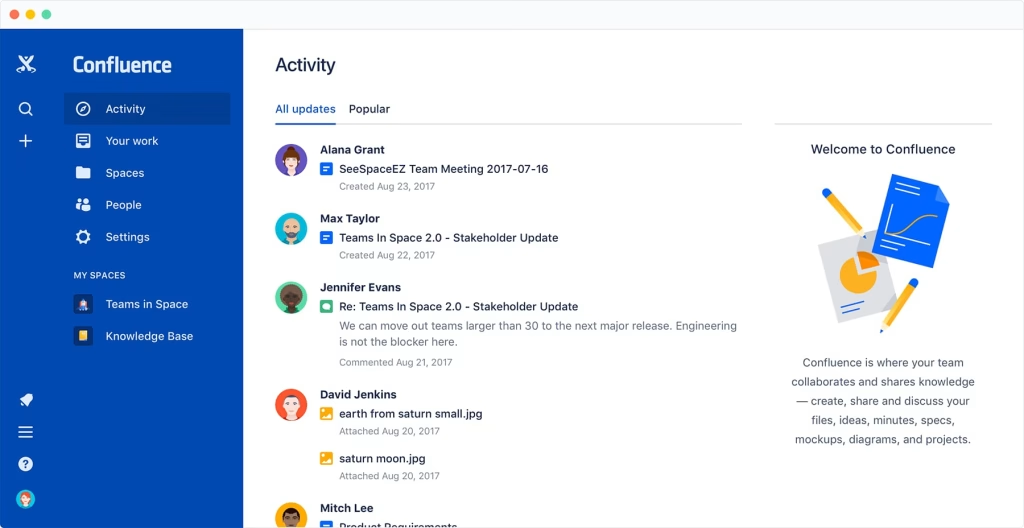
Best for Knowledge management and team documentation.
Confluence, by Atlassian, is a powerful tool for creating and managing team knowledge bases. It allows teams to organize, collaborate on, and share information effectively through customizable spaces and pages. Confluence integrates seamlessly with Jira, making it an excellent option for teams already using Atlassian’s suite of tools to manage projects and track tasks.
In addition to its integration with Jira, Confluence supports numerous other plugins and integrations, including Slack, Trello, and Google Workspace, to streamline workflows and improve team collaboration. Its features include templates for creating consistent content, robust version control to track changes, and powerful search capabilities to locate information quickly.
Confluence is also highly customizable, allowing teams to tailor their spaces with branding, layout preferences, and specialized plugins. Its real-time collaboration tools, such as inline comments and notifications, enable teams to work together efficiently, even in remote environments. Whether for project documentation, brainstorming, or creating an internal wiki, Confluence provides a flexible and scalable platform for teams of all sizes.
Pricing (per user per month)
- Free Plan: Yes, available for up to 10 users.
- Standard: $5.75
- Premium: $11
- Enterprise: Pricing available upon request; tailored for organizations requiring advanced features and support
Wrap-Up
Choosing the right collaboration platform depends on your team’s unique needs and workflows. While SharePoint remains a robust solution, alternatives like FuseBase, Google Workspace, and others offer modern features that cater to different organizational demands.
FuseBase stands out as a top choice with its customizable portals and AI-driven tools, enabling teams to streamline collaboration, enhance productivity, and stay aligned. For those seeking flexibility and innovation, exploring these alternatives can open up new opportunities.
As technology evolves, so do the tools available for teamwork. Take the time to evaluate your options and select a platform that empowers your team to achieve its goals more effectively.